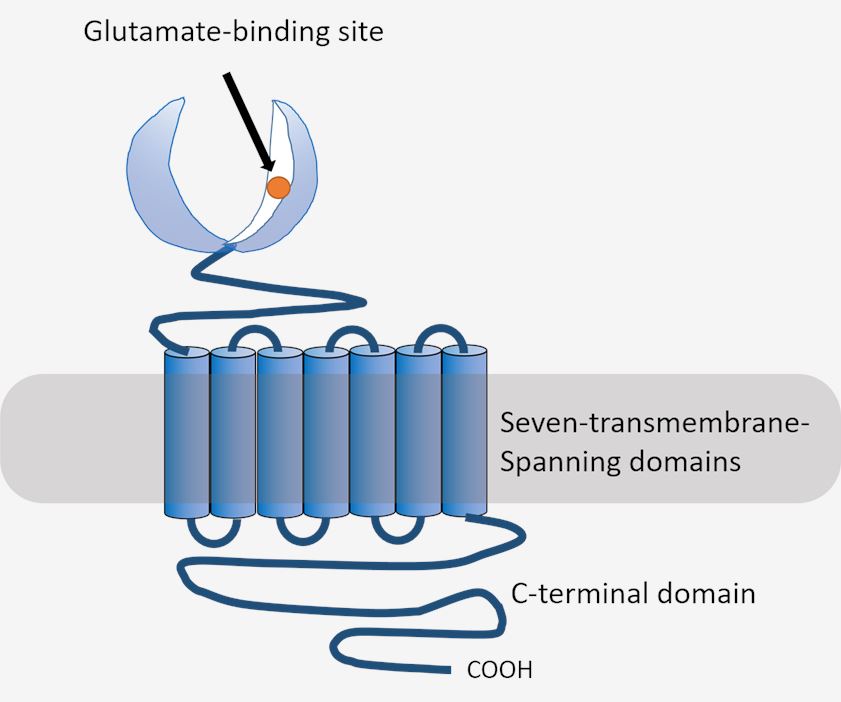Introduction of GRM7
GRM7 (mGluR7) is one of the group III metabotropic glutamate receptors (mGluRs) that are coupled predominantly to Gi/o proteins. They are family C G-protein coupled receptors that are generally characterized by the presence of a large extracellular domain that contains the endogenous ligand-binding site. Different splice variants of GRM7 exist due to alternative splicing. This receptor exhibits a wide distribution throughout the entire brain and is highly localized to the active zones of synapses. Moreover, they have displayed an extremely low affinity for glutamate and only become active when glutamate levels are very high. It modulates excitatory neurotransmission and synaptic plasticity by inhibiting neurotransmitter release.
| Basic Information of GRM7 | |
| Protein Name | Metabotropic glutamate receptor 7 |
| Gene Name | GRM7 |
| Organism | Homo sapiens (Human) |
| UniProt ID | Q14831 |
| Transmembrane Times | 7 |
| Length (aa) | 915 |
| Sequence |
MVQLRKLLRVLTLMKFPCCVLEVLLCALAAAARGQEMYAPHSIRIEGDVTLGGLFPVHAK GPSGVPCGDIKRENGIHRLEAMLYALDQINSDPNLLPNVTLGARILDTCSRDTYALEQSL TFVQALIQKDTSDVRCTNGEPPVFVKPEKVVGVIGASGSSVSIMVANILRLFQIPQISYA STAPELSDDRRYDFFSRVVPPDSFQAQAMVDIVKALGWNYVSTLASEGSYGEKGVESFTQ ISKEAGGLCIAQSVRIPQERKDRTIDFDRIIKQLLDTPNSRAVVIFANDEDIKQILAAAK RADQVGHFLWVGSDSWGSKINPLHQHEDIAEGAITIQPKRATVEGFDAYFTSRTLENNRR NVWFAEYWEENFNCKLTISGSKKEDTDRKCTGQERIGKDSNYEQEGKVQFVIDAVYAMAH ALHHMNKDLCADYRGVCPEMEQAGGKKLLKYIRNVNFNGSAGTPVMFNKNGDAPGRYDIF QYQTTNTSNPGYRLIGQWTDELQLNIEDMQWGKGVREIPASVCTLPCKPGQRKKTQKGTP CCWTCEPCDGYQYQFDEMTCQHCPYDQRPNENRTGCQDIPIIKLEWHSPWAVIPVFLAML GIIATIFVMATFIRYNDTPIVRASGRELSYVLLTGIFLCYIITFLMIAKPDVAVCSFRRV FLGLGMCISYAALLTKTNRIYRIFEQGKKSVTAPRLISPTSQLAITSSLISVQLLGVFIW FGVDPPNIIIDYDEHKTMNPEQARGVLKCDITDLQIICSLGYSILLMVTCTVYAIKTRGV PENFNEAKPIGFTMYTTCIVWLAFIPIFFGTAQSAEKLYIQTTTLTISMNLSASVALGML YMPKVYIIIFHPELNVQKRKRSFKAVVTAATMSSRLSHKPSDRPNGEAKTELCENVDPNS PAAKKKYVSYNNLVI |
Functions of GRM7 Membrane Protein
The functions of GRM7 have not been completely understood. However, because the GRM7 receptors are expressed mainly in brain regions implicated in emotional learning and working memory, studies have revealed a role of this receptor in different neurocognitive and psychopathological behavioral phenomena. Firstly, GRM7 knockout mice have shown an epileptic phenotype and abnormalities in learning tasks. Secondly, GRM7 may play a critical role in mediating amygdala-dependent learning. Moreover, studies have suggested a role of this receptor in CNS disorders such as anxiety and depression. Agonists, antagonists, and negative allosteric modulators have been developed targeting GRM7 for therapeutic purposes. For instance, the GRM7 allosteric agonist AMN082 has been found to improve haloperidol-induced catalepsy and reserpine-induced akinesia in the rat.

Applications of GRM7 Membrane Protein in Literature
This article investigated the SUMO conjugation of mGluR7 and found that SUMOylation of mGluR7 at Lys889 was required for its stable surface expression in neurons.
This article investigated the effect of mGluR7 allosteric agonist AMN082 on depression-like behaviors and the mechanisms for mediating it. The results confirmed the hypothesis that mGluR7 could represent a novel target for treating depression.
This article demonstrated that activation of mGluR7 with a group III mGluRsorthosteric agonist LAP4 or a mGluR7 allosteric agonist AMN082 significantly attenuated sevoflurane-induced neuronal apoptosis. Moreover, β-arr1 and 2 may differently modulate mGluR7 signaling in developmental sevoflurane neurotoxicity.
This study demonstrated the genetic association of GRM7 and GRM8 with schizophrenia and major depressive disorders in the Han Chinese population.
The study investigated the role of mGluR7 in pain signaling in the dorsal striatum of neuropathic rats and the mechanisms. The results showed that the effect of mGluR7 in pain signaling may be resulting from the recruitment of different pathways of the basal ganglia.
GRM7 Preparation Options
Membrane proteins such as GRM7 are required to be isolated and stabilized in a membrane-like environment for subsequent structural and functional studies. At Creative Biolabs, we are proud to recommend our powerful Magic™ membrane protein production platform to obtain your target protein in a variety of formats, ranging from traditional detergent micelles to new polymers and nanodiscs. Our seasoned scientists will assist you in the selection of an optimal reconstitution system from various choices. Aided by our versatile Magic™ anti-membrane protein antibody discovery platform, we also provide customized anti-GRM7 antibody development services.
Creative Biolabs is specialized in production, purification, and characterization of different classes of membrane proteins, such as ion channels, membrane transporters, and GPCRs. We are happy to share our expertise with our clients to promote their brilliant studies. Please feel free to contact us for more information.
All listed services and products are For Research Use Only. Do Not use in any diagnostic or therapeutic applications.